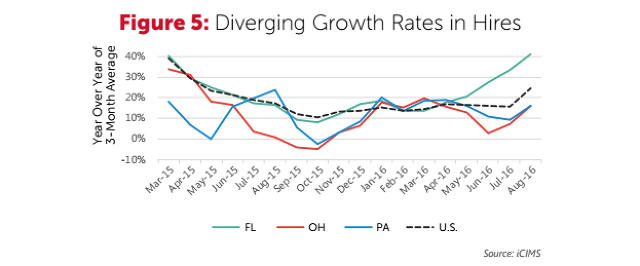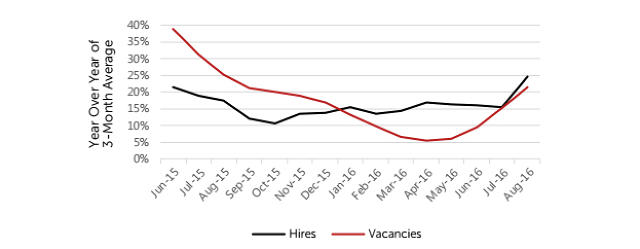Job Growth In Swing States Isn’t As Bad As Presidential Candidates Say
If you’ve been listening to the candidates speak about jobs during the run up to the 2016 presidential election, you might be convinced that the sky is falling.
Donald Trump has assured voters that all of their jobs have moved to China, Mexico, and elsewhere. During last night’s debate, he declared that “thousands” of jobs would be lost when Ford moved operations to Mexico. Ford insists that’s not true. For her part, Hillary Clinton has made revitalizing the employment market a top priority for her first 100 days in office, should she be elected.
But in the swing states that may decide the outcome of this election, the hiring landscape isn’t nearly as bad as they’d have you believe. In the battleground states of Florida, Ohio, and Pennsylvania, which represent a combined 67 electoral votes, the doom and gloom espoused by the candidates about declining jobs figures is not entirely consistent with reality.
According to a recent study by iCIMS’ chief economist, Josh Wright, Florida is experiencing job growth that outpaces the rest of the country, Ohio is returning to national averages after experiencing a slowdown in late 2015 and early 2016, and Pennsylvania has seen its unemployment rate level off in recent months.
In fact, three of Ohio’s cities and one of Pennsylvania’s ranked among the top 25 for jobs in 2016 according a study conducted by Glassdoor in May. The study found that there were more than 35,000 available positions each in Cleveland, Columbus, and Cincinnati in industries ranging from health care to technology, finance, sales, and marketing. During that same month, the study found that Pittsburgh had more than 50,000 open jobs, most of which were for mechanical engineers, nurse practitioners, and product managers.
Florida, meanwhile, was becoming a startup state, boasting the country’s second-highest rate of new business production in 2014.

“Unfortunately, the divergence between the headline statistics and what people are actually experiencing has too often bred confusion and cynicism about labor data, rather than inspired greater curiosity and critical thinking about the changes in the economy,” says Wright.
Wright explains that historically speaking, a negative perception of the economy typically favors the challenging party while a strong job growth benefits the incumbent party. Pollsters remain unsure of just how much of an impact job figures can have. Political scientists have argued that job creation impacts the outcome of the election by a factor of somewhere between 40% and 90%, according to Wright. “Whatever the magic number is, jobs are a big deal,” he adds.
In his study, Wright zeroed in on a few key counties that could determine the results of the presidential election, including Hillsborough County (Tampa) and Orange County (Orlando) in Florida; Franklin County (Columbus), Hamilton County (Cincinnati), and Wood County in Ohio; and Montgomery and Delaware Counties (straddling Philadelphia) in Pennsylvania.

“In the last three presidential elections, these counties in Florida and Ohio have voted for the successful candidate, regardless of his party affiliation,” says Wright. “In Pennsylvania, the two counties have previously voted for the Democratic nominee, but their size and tendency to vote Republicans into local office have attracted speculation that they could turn Republican, taking the state’s Electoral College votes with them,” he adds.
Florida’s swing counties have seen strong hiring trends, according to Wright, but only in the past few months. Ohio has lagged behind national job trends as a whole, but Hamilton and Wood counties have outpaced the state and are experiencing job growth consistent with the rest of the country.
Pennsylvania’s swing counties, however, have underperformed, even when compared to the slow growth of the state as a whole. “In Montgomery County, the proportion of full-time positions is elevated and in Delaware County it has risen, but remains below average,” he observes.

Wright maintains that most of these swing counties in Florida and Ohio continue to see strong hiring trends overall. “This contrasts with widespread reports of nationwide dissatisfaction with the direction the country is headed,” he points out, “and concerns about income inequality and the nature of the new jobs being created.” Still he says, “In some ways, Pennsylvania’s figures look more consistent with the fears of malaise.”
Economic data has been a strong indicator of election outcomes in the past, however, Wright admits that the race to the Oval Office between the two least popular candidates in decades may be without historical precedent. In other words, in the 2016 election, all bets are off.
Fast Company , Read Full Story
(18)













